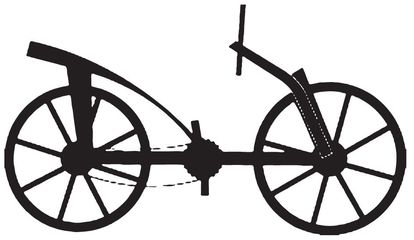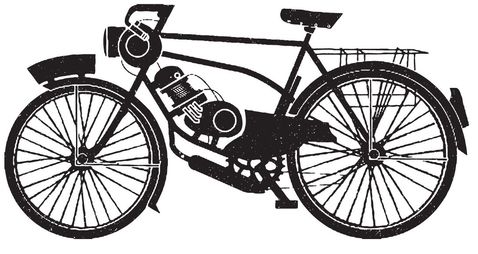Cyclopedia (14 page)
Authors: William Fotheringham
Â
The cyclo-sportive phenomenon of the 1990s drew heavily from mountain biking, and there are many well-established off-road sportives such as the Rough Ride in Britain's Welsh Borders and the Hell of the North Cotswolds.
Â
(SEE
ALPS
,
PYRENÃES
, AND
DOLOMITES
FOR EVENTS THAT TAKE IN THESE LEGENDARY MOUNTAIN RANGES; SEE
MOUNTAIN BIKES
FOR THE BEST OFF-ROAD SPORTIVES)
ALPS
,
PYRENÃES
, AND
DOLOMITES
FOR EVENTS THAT TAKE IN THESE LEGENDARY MOUNTAIN RANGES; SEE
MOUNTAIN BIKES
FOR THE BEST OFF-ROAD SPORTIVES)

D
DA VINCI, Leonardo
Learned and heated debate has raged for three decades among a small group of art historians about Leonardo's “bicycle.” The issue is whether, at the very end of the 15th century, the Italian artist and inventor, or one of his pupils, actually drew what appears to be a sketch for a bicycle, or whether the image is a fake added in the 1960s by patriotic restorers who were keen to claim the bike's parentage for Italy.
Scholars believe the bike may have been drawn around 1493; the drawing is on the back of papers later used for architectural sketches. About this time, Leonardo was developing chain and cog wheel devices. There is much discussion of ink types and lost manuscript sheets, but no one knows the answer.
Â
(SEE
DRAISIENNE
AND
HOBBY HORSE
TO LEARN HOW THE BIKE WAS BORN)
DRAISIENNE
AND
HOBBY HORSE
TO LEARN HOW THE BIKE WAS BORN)


DE VLAEMINCK, Roger
Born:
Eeklo, Belgium, August 4, 1947
Eeklo, Belgium, August 4, 1947
Â
Major wins:
MilanâSan Remo 1973, 1978â9; Tour of Flanders 1977; ParisâRoubaix 1972, 1974â5, 1977; LiègeâBastogneâLiège 1970; Giro di Lombardia 1974, 1976; Het Volk 1969, 1979; Flèche Wallonne, 1971; Championship of Zurich 1975, Paris-Brussels 1981; Tour of Switzerland 1975; world cyclo-cross champion 1975
MilanâSan Remo 1973, 1978â9; Tour of Flanders 1977; ParisâRoubaix 1972, 1974â5, 1977; LiègeâBastogneâLiège 1970; Giro di Lombardia 1974, 1976; Het Volk 1969, 1979; Flèche Wallonne, 1971; Championship of Zurich 1975, Paris-Brussels 1981; Tour of Switzerland 1975; world cyclo-cross champion 1975
Â
Nicknames:
the Beast of Eeklo, the Gypsy
the Beast of Eeklo, the Gypsy
Â
Possessor of the finest pair of sideburns cycling has ever seen, more importantly De Vlaeminck was the best CLASSIC rider of the 1970s after EDDY MERCKX. Between 1972 and 1977 he won PARISâ
ROUBAIX four times, which is still the record. He rode the race every year bar one between 1969 and 1982, never finishing lower than seventh. The one major single-day race to elude him was the world road championship.
He remains one of FLANDERS' and cycling's great characters: after retirement he was to be found living on a farm outside his home village along with a vast menagerie of animals that included ducks and deer, and he was still trying to outride professionals and amateurs a third his age as he entered his 60s. De Vlaeminck's training rides over the border into Holland are legendary: each rider spends 1 km on the front, single file is maintained, and not a word spoken.
De Vlaeminck was born into a family of traveling clothiers and thus acquired the nickname “the Gypsy” at school. He never attained Merckx's popularity and avoided the TOUR DE FRANCE once it became clear that he would not match Merckx in the event. The pair had a bitter rivalry early in the 1970s, whipped up by the national press. “When a Belgian daily paper ran a photograph of Merckx entertaining De Vlaeminck at his breakfast table, it was as if the Pope had been caught supping with the Devil,” wrote Geoffrey Nicholson. (See RIVALRIES for other great cycling head-to-heads.)
Later, however, the two Belgians buried the hatchet and formed an alliance against another Classics specialist, Freddy Maertens; De Vlaeminck's son is named after
Merckx. While never a Tour de France star, he was one of the few cyclists capable of winning any one of the Classics, be it in the steep hills of the Ardennes, the sprint finish of MilanâSan Remo, or the cobbles of ParisâRoubaix. He was also a winner of the CYCLO-CROSS world championship and took a massive 22 stage wins in the Giro d'Italia.
Merckx. While never a Tour de France star, he was one of the few cyclists capable of winning any one of the Classics, be it in the steep hills of the Ardennes, the sprint finish of MilanâSan Remo, or the cobbles of ParisâRoubaix. He was also a winner of the CYCLO-CROSS world championship and took a massive 22 stage wins in the Giro d'Italia.

DEFEATS
Unfairly, some cyclists are better known for losing than for winning. LAURENT FIGNON has gone down in cycling history for being just 8 seconds adrift of victory in the 1989 TOUR DE FRANCE, a record margin estimated at about 100 m in a race lasting 3,285 km and 87.5 hours. As Fignon said, “Eight seconds, 20 seconds, a minute, what's the difference?” Not all notable runners-up have said similar things. A year after Fignon's defeat, the Canadian Steve Bauer came within a millimeter or two of winning PARISâROUBAIX, only for the photofinish to be awarded to Eddy Planckaert of Belgium. “Second in Roubaix is OK l guess,” was his reaction.
Unfairly, some cyclists are better known for losing than for winning. LAURENT FIGNON has gone down in cycling history for being just 8 seconds adrift of victory in the 1989 TOUR DE FRANCE, a record margin estimated at about 100 m in a race lasting 3,285 km and 87.5 hours. As Fignon said, “Eight seconds, 20 seconds, a minute, what's the difference?” Not all notable runners-up have said similar things. A year after Fignon's defeat, the Canadian Steve Bauer came within a millimeter or two of winning PARISâROUBAIX, only for the photofinish to be awarded to Eddy Planckaert of Belgium. “Second in Roubaix is OK l guess,” was his reaction.
The most famous and popular loser of all was RAYMOND POULIDOR of France, the first man to be nicknamed the “Eternal second” after finishing second or third in the Tour eight times. Poulidor lost the 1964 Tour by 55 secondsâan astonishingly small margin at a time when margins of 5 to 10 minutes were not uncommonâyet lost a minute when he sprinted for a 60 second time bonus on the wrong lap at a stage finish. The second “Eternal second” was Joop Zoetemelk, a Dutchman who made a fine comeback from a life-threatening head injury to finish runner-up in the Tour six times between 1971 and 1982. Jan Ullrich, who managed five second places in six starts to one win between 1996 and 2003, was the third.
Unlucky losers are everywhere in cycling, but few are as
unfortunate as the French sprinter Lucien Michard, who was given second place in the 1931 world championship in spite of photofinish evidence and even though his opponent Falk Hansen of Denmark declared that he had definitely lost. Officials simply pointed at the rule book that said their decision was final and gave Hansen the gold medal.
unfortunate as the French sprinter Lucien Michard, who was given second place in the 1931 world championship in spite of photofinish evidence and even though his opponent Falk Hansen of Denmark declared that he had definitely lost. Officials simply pointed at the rule book that said their decision was final and gave Hansen the gold medal.

DEFENSIVE CYCLING
Term used to describe the tactics cyclists adopt to protect themselves from motorists on busy modern roads. Cyclists view this as defensive assertion of their right to space in order to avoid injury or worse; motorists may not share that view.
Term used to describe the tactics cyclists adopt to protect themselves from motorists on busy modern roads. Cyclists view this as defensive assertion of their right to space in order to avoid injury or worse; motorists may not share that view.
Defensive tactics include:
⢠Looking over the shoulder at cars approaching from the rear to alert the driver to the fact that the thing in front is a human being. Riding out of the saddle and wobbling slightly works as well, as this gives the cyclist a bigger profile, encouraging the car driver to give the cyclist more road space.
⢠Pulling out a little to prevent drivers overtaking on blind bends, indicating if necessary that the driver is to stay behind.
⢠Pulling out before a left-hand junction to prevent a car from overtaking and then cutting in to turn left.
⢠Riding a little further out from the gutter than might be expected to create “escape space” if a truck overtakes or a car comes too close.
⢠Allowing space when riding down a line of parked cars for the one driver in a hundred who hasn't seen you coming and opens his door on your fast-moving knee.

DERAILLEUR
see GEARS
see GEARS

DERNY
Small motorbike with a gas tank across the handlebars used in TRACK RACING. Dernys have a 98 cc two-stroke engine backed up by the driver pedaling a large fixed gear, typically 70 Ã 11, giving smooth acceleration and deceleration. They have to be bump-started, and their top speed is about 50 mph.
Small motorbike with a gas tank across the handlebars used in TRACK RACING. Dernys have a 98 cc two-stroke engine backed up by the driver pedaling a large fixed gear, typically 70 Ã 11, giving smooth acceleration and deceleration. They have to be bump-started, and their top speed is about 50 mph.
Dernys take the field up to speed in the opening laps of international KEIRIN races, are used to pace riders in MOTORPACE races at track meetings, and can be seen making the pace in training and warming up. They were also used for many years in the BordeauxâParis motorpaced CLASSIC.
They are named after the firm that first made them in 1938, Roger Derny et Fils in Ave St. Mande, Paris. Derny et Fils shutdown in 1957, and most of the machines are now made in Neerpelt, Belgium. The term is listed in the French dictionary
Larousse
as a generic description for a small pacing motorbike. Contrary to popular belief, there is no contractual obligation for the drivers to be overweight, to have bizarre facial hair, and to wear obscure Belgian cycle club jerseys. It's just coincidence.
Larousse
as a generic description for a small pacing motorbike. Contrary to popular belief, there is no contractual obligation for the drivers to be overweight, to have bizarre facial hair, and to wear obscure Belgian cycle club jerseys. It's just coincidence.

Other books
Night's Favour by Parry, Richard
The Ex-Mrs. Hedgefund by Jill Kargman
People Park by Pasha Malla
Bal Masque by Fleeta Cunningham
The Pepper In The Gumbo: A Cane River Romance by Hathaway, Mary Jane
The Mother Hunt by Rex Stout
Redeeming the Night by Kristine Overbrook
The Artifacts Of Elios (Book 1) by R N Skye
Captured In Ink (Art of Love Series) by McDonald, Donna
The Master Falconer by Box, C. J.